
Cha Gordo (literally Fat Tea [1] ) is a culinary tradition amongst the Macanese community in Macau that is likened to high tea. [1]

Cha Gordo (literally Fat Tea [1] ) is a culinary tradition amongst the Macanese community in Macau that is likened to high tea. [1]
Historically, families with Portuguese heritage in Macau would host a Cha Gordo for a number of occasions, including Catholic holidays, christening, or birthdays, but it can be held for any reason. [2] Some families, historically, would even host one on a weekly basis. [1]
A Cha Gordo would take place following a Macanese wedding, instead of the elaborate banquet seen in Chinese weddings. [3]
Cha Gordos are noted to be elaborate, [4] consisting of 12 dishes or more. [1] Cha Gordos typically start in the mid-afternoon, in order to allow the children to eat, and allow the adults to continue on with the entertainment, as the children go to bed. [2]
Some of the dishes included in a Cha Gordo include Bolinhos de bacalhau, Minchi, Sopa de lacassá, and Tacho. [1] [2] [5]
Due to cramped living conditions in modern-day Macau, Cha Gordo has become a much rarer affair, [6] but they have been held as community events on a regular basis (such as on Christmas), in an effort to preserve Macanese culture. [6]
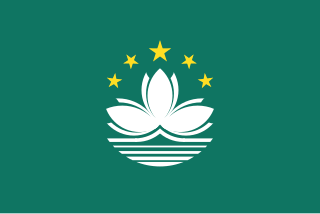
Macau or Macao is a special administrative region of the People's Republic of China. With a population of about 710,000 people and a land area of 32.9 km2 (12.7 sq mi), it is the most densely populated region in the world.
The Macanese people are a multiracial East Asian ethnic group that originated in Macau in the 16th century, consisting of people of predominantly mixed Cantonese and Portuguese as well as Malay, Japanese, English, Dutch, Sinhalese, and Indian ancestry.

Yum cha is the Cantonese tradition of breakfast or brunch involving Chinese tea and dim sum. The practice is popular in Cantonese-speaking regions, including Guangdong province, Guangxi province, Hong Kong, and Macau. It is also carried out in other regions worldwide where there are overseas Cantonese communities. Yum cha generally involves small portions of steamed, pan-fried, or deep-fried dim sum dishes served in bamboo steamers, which are designed to be eaten communally and washed down with hot tea. People often go to yum cha in large groups for family gatherings and celebrations.
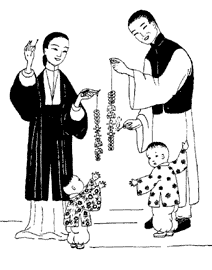
The Qingming Festival or Ching Ming Festival, also known as Tomb-Sweeping Day in English, is a traditional Chinese festival observed by ethnic Chinese in mainland China, Hong Kong, Macau, Taiwan, Malaysia, Singapore, Cambodia, Indonesia, Philippines, Thailand, and Vietnam. A celebration of spring, it falls on the first day of the fifth solar term of the traditional Chinese lunisolar calendar. This makes it the 15th day after the Spring Equinox, either 4, 5 or 6 April in a given year. During Qingming, Chinese families visit the tombs of their ancestors to clean the gravesites and make ritual offerings to their ancestors. Offerings would typically include traditional food dishes and the burning of joss sticks and joss paper. The holiday recognizes the traditional reverence of one's ancestors in Chinese culture.

Bengali cuisine is the culinary style of Bengal, that comprises Bangladesh and the Indian state of West Bengal, and Assam's Karimganj district. The cuisine has been shaped by the region's diverse history and climate. It is known for its varied use of flavours including mustard oil, as well as the spread of its confectioneries and desserts. There is a strong emphasis on rice as a staple, with fish traditionally the most common protein. Freshwater fish are preferred to seafish, although barramundi, known as bhetki, is also common. Meat is also a common protein among Bengalis with chicken, mutton meat being the most popular. Beef is popular within the muslim community. In more recent times, lentils have begun to form a significant part of the diet. Many Bengali food traditions draw from social activities, such as adda, Poila Boishakh and Durga Puja.

Cha chaan teng, often called a Hong Kong-style cafe or diner in English, is a type of restaurant that originated in Hong Kong. Cha chaan tengs are commonly found in Hong Kong, Macau, and parts of Guangdong. Due to the waves of mass migrations from Hong Kong in the 1980s, they are now established in major Chinese communities in Western countries such as Australia, Canada, the United Kingdom, and the United States. Likened to a greasy spoon cafe or an American diner, cha chaan tengs are known for eclectic and affordable menus, which include dishes from Hong Kong cuisine and Hong Kong-style Western cuisine. They draw comparisons to Western cafés due to their casual settings, as well as menus revolving around coffee and tea.

Tourism is a major industry in Macau. It is famous for the blend of Portuguese and Chinese cultures and its gambling industry, which includes Casino Lisboa, Macau, Sands Macau, The Venetian Macao, and Wynn Macau.
Macanese cuisine is mainly influenced by Chinese cuisine, especially Cantonese cuisine and European cuisine, especially Portuguese cuisine and influences from Southeast Asia and the Lusophone world, due to Macau's past as a Portuguese colony and long history of being an international tourist gambling centre.

The egg tart is a kind of custard tart found in Chinese cuisine, derived from the English custard tart and Portuguese pastel de nata. The dish consists of an outer pastry crust filled with egg custard. Egg tarts are often served at dim sum restaurants, Chinese bakeries and cha chaan tengs.
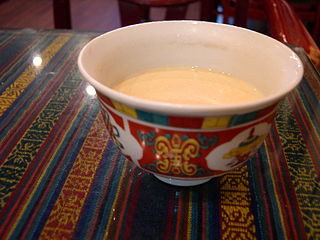
Butter tea, also known as Bho jha, cha süma and Su Chya in the Sherpa language, is a drink of the people in the Himalayan regions of Nepal, Bhutan, India, Pakistan especially in Khyber Pakhtunkhwa and Gilgit-Baltistan, Afghanistan, Kazakhstan, Tajikistan, East Turkestan, Tibet and western regions of modern-day China and Central Asia. Traditionally, it is made from tea leaves, yak butter, water, and salt, although butter made from cow's milk is increasingly used, given its wider availability and lower cost.

Portuguese chicken, also known as Portuguese-style chicken or galinha à portuguesa is a dish found in Macanese cuisine.

African chicken, also known as galinha à africana (Portuguese:[ɡɐˈlĩɲaafɾiˈkɐ̃nɐ], is a Macanese chicken dish.

Minchee, or minchi, is a Macanese dish based on minced or ground meat stir-fried with vegetables and seasoned. It is widely considered Macau's national dish.
Nam Van is a collection of short stories by the Macanese author Henrique de Senna Fernandes. It was first published in Macau in 1978. Taking its name from Praia Grande also known as Nam Van in Chinese, written in Portuguese, the collection is an attempt to sketch out aspects of the identity of the Macanese, the mixed race community considered by the Chinese and the Portuguese to be the sons of the soil. In Senna Fernandes's stories, this group is depicted as inextricably in-between, in-between the Portuguese and the Chinese, in between a seemingly idyllic past and a fast approaching present that will see the territory transformed and their place within it rendered fragile,
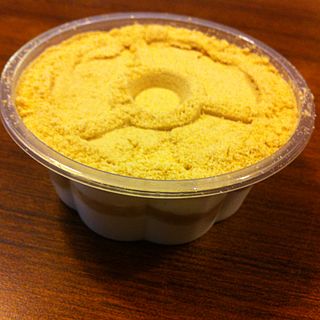
Serradura, also known as sawdust pudding or Macau pudding, is a well-known Portuguese dessert, popular in both Portugal and Macau, as well as Goa, with a layered appearance alternating between whipped cream and crumbled Marie biscuit.

Lacassá Soup is a Macanese soup.
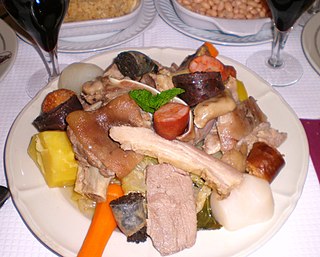
Tacho, also known as Chau-Chau Pele, is a type of meat and vegetable stew or casserole of Macanese cuisine that is a local variant of cozido à Portuguesa, found in Portuguese cuisine, which heavily influenced Macanese cuisine during colonization. Its preparation and serving is similar to a pot-au-feu or boiled dinner.
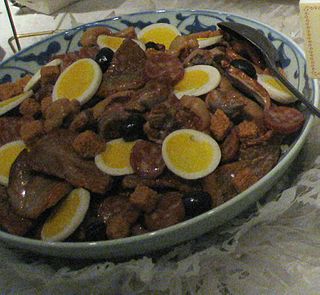
Arroz gordo is a rice dish that is often consumed by Eurasian communities in Goa, Macao, Malaysia, and Singapore. It has been likened to a variant of Paella.
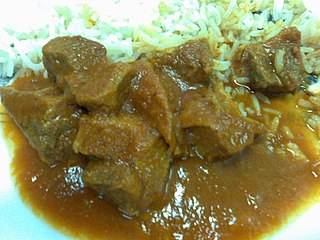
Balichão is an ingredient that is used in a number of dishes in Macanese cuisine. It is made with shrimp, alcohol, salt, pepper, bay leaves and malagueta chillies.

Bashkir cuisine is the traditional cuisine of the Bashkirs. Their way of life, and the predominance of cattle breeding contributed culture, traditions, and cuisine of the Bashkirs.